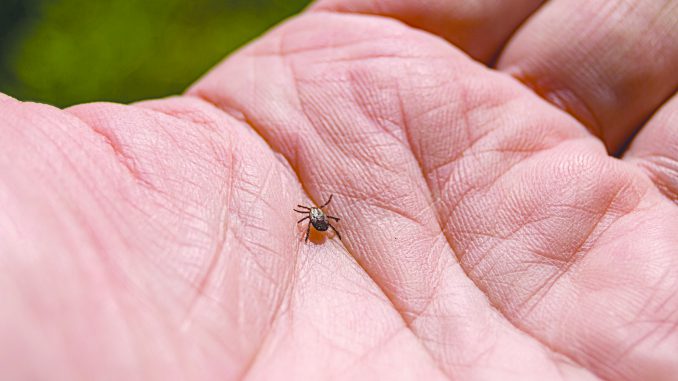
By Christine Craddock
Lyme.
Its simple name belies an ominous threat — a disease that strikes residents in Ashburn and much of Virginia indiscriminately and at higher rates than in many other parts of the country.
Almost everyone in Ashburn knows the drill — lots of wildlife and lots of woods equals lots of black-legged deer ticks. A bite from an infected tick can quickly transfer the Lyme bacteria to a person.
We study how to carefully remove a tick, how to avoid a bite by tucking our pants in our socks, how to do careful “tick checks” of ourselves and our loved ones.
Still, the number of patients with Lyme grows each year. In just five years — 2014 to 2018 — nearly a thousand cases of Lyme were reported in Loudoun County, according to the Virginia Department of Health. And health experts say there are many more cases that are never formally reported.
A common belief around the area is that Loudoun has the highest Lyme disease rate anywhere in Virginia, maybe even in the country. That’s not really true statistically, but we are often near the top of the list.
“Each year, Loudoun and Fairfax typically rank among the highest in total numbers of Lyme cases,” said Dr. David Goodfriend, director of the Loudoun County Department of Health. “Because of our larger populations, though, we no longer have the highest rate of infection, with some of the more rural counties along the Piedmont experiencing significant increases in Lyme.”
But statistics go out the window if you’re one of the thousands of local residents dealing with Lyme. A day walking your dog or playing in the park can have repercussions that last a lifetime.
SUZIE & AIDAN CREECH
Suzie Creech remembers the day vividly. The day her son, Aidan, was bitten by a tick outside his elementary school in the Broadlands. The day their lives changed.
“It had been raining,” Creech said. “Aidan came out after school with the other kids and they ran into the little woods next to Hillside. The kids liked to play in there. It was muddy and gross — I had to go in after him.”
The next morning, she found a tick on her son. Soon, the bite location was surrounded by a red ring — known as a “bull’s-eye.” That same week, while in the shower, Creech found a tick on herself as well.
Within months, Aidan went from an active first-grader to an entirely different child. Creech says he was lethargic — wouldn’t go out to play. He couldn’t ride his bike because his knees hurt. He had headaches, and his stomach was frequently upset.
Soon, Creech herself started to show symptoms. Body pain, headaches and what she calls “foggy brain” — trouble concentrating.
After multiple visits to different doctors — many of whom Creech says dismissed the possibility of Lyme disease — followed by a battery of tests, the results at long last came back: both Suzie and her son had Lyme disease.
After several years of traditional and non-traditional treatments, both Creeches are in good health and consider themselves Lyme-free. But the trauma they went through stays with the family.
“Trust your instincts – you know your own body and your child better than anyone else,” said Creech, who admitted getting into shouting matches with doctors who dismissed Lyme as a possibility. “Don’t let anyone convince you otherwise.”
JACLYN O’BRIEN
Jaclyn O’Brien believes she was bitten by an infected tick years ago while walking with her dog.
She felt flu-like symptoms but initially didn’t think much of it. But six months later, when extreme joint and muscle pain, vertigo, numbness and cognitive issues started, she sought medical treatment.
Yet doctor after doctor told her nothing was wrong.
“You start to feel crazy,” said O’Brien, 36, who lives in Ashburn’s Chelsea Courts neighborhood north of Route 7. “People think you are making it up, but you know you’re not.”
Years went by, but it wasn’t until O’Brien found a doctor she calls “Lyme literate” that testing confirmed it was Lyme disease.
“When I was finally diagnosed, I felt relieved and validated,” she said. “Someone believes me, and I have an answer.’”
Unfortunately, O’Brien assumed she would simply take medicine and be cured. But the repeated misdiagnoses and delay in getting treatment had taken a toll.
The mental and physical problems continued unabated.
“I finally got down on my knees and prayed to God and said, ‘I don’t want to keep taking medicines. I don’t want to be in a wheelchair in my 30s,’” she said.
O’Brien made a complete lifestyle change — stopped antibiotics, changed her diet, started doing yoga. She says results came quickly. Within nine months, she felt nearly back to normal.
Determined to help others going through similar struggles, O’Brien founded KeyLyme, an organization focused on awareness, education, and prevention. KeyLyme sponsors local Lyme awareness events, answers questions on social media and even markets an all-natural tick repellent at various local stores.
Her message is the same over and over again — and echoes that of others who have gone down this path: Be your own best advocate.
“All of this pain and torture could have been prevented had I been educated and aware of Lyme disease,” she said.
LUCA SCIULLO
In the summer of 2012, Luca Sciullo was 31 years old, a busy government contractor living in Ashburn with his wife and two children. (Today, he has four kids.)
In August of that year, he noticed a bull’s-eye-shaped rash on his left thigh.
“I thought it was sort of weird,” he recalled.
When it didn’t go away, he went to the doctor. Unlike many, Sciullo’s diagnosis came quickly: The bull’s-eye was the first sign of Lyme infection.
Despite not having any symptoms, he quickly began taking antibiotics. And that’s when things went downhill. He had what’s known as a Herxeimer reaction — the body responding to dying bacteria in his system.
“I pretty quickly started experiencing every symptom on the Lyme disease list,” Sciullo said, including mental fog and weakness. “One second you’re going to your office to grab something and then you’re like, ‘What am I doing here?’ I felt like I was a hundred years old. I’d get to the top step and struggle to get my leg up.”
What followed was several years of antibiotics, medicines, vitamins, supplements, holistic treatments, dietary changes and more.
Overall, the continual treatments eventually helped. Sciullo says by 2016, he felt “75 to 80 percent” back to normal. And then he was diagnosed with thyroid cancer — a condition he continues to live with today.
“A part of me wonders if the cancer was an outgrowth or a secondary effect of the Lyme disease,” said Sciullo. “And I do have some apprehension that [Lyme] is still a part of me. I’ve had some co-viruses that are common with Lyme disease and I wonder if there’s more crap coming in the future. But honestly, I don’t worry about it.”
THE LOWDOWN ON LYME DISEASE
So, what precisely is Lyme disease? How do you get it? And why is it so common in Loudoun? We took these questions to an expert, Monte Skall, executive director of the National Capital Lyme Disease Association and a Lyme disease patient herself.
WHAT IS LYME DISEASE?
“Lyme Disease is the number one vector-borne infectious disease in the United States,” Skall said. “Vector borne” means transmitted by bug bites – bugs like ticks. In the case of Lyme, it’s a type of bacteria transmitted by the bite of the black-legged tick, also known as the deer tick.
WHY IS LYME SO PREVALENT IN LOUDOUN?
Skall believes it’s a combination of the rapid development of the county — including the Ashburn area — and the dramatic increase in our population. This is putting more people in contact with ticks than ever before. Add in that health experts say the tick population has boomed in Northern Virginia in the past 20 years, and it’s a recipe for more tick bites and more Lyme transmissions.
WHAT ARE THE SYMPTOMS?
According to WebMD, the first sign is usually a bull’s-eye rash. This can be followed by flu-like feelings — fatigue, headache, fever, sore throat, chills, or body aches. You may have some joint pain. Some people also get other symptoms, including a stiff neck, sensitivity to light, memory loss, mood changes, rashes that keep returning, and even paralysis of one or both sides of the face, heart rhythm problems, and areas of tingling or numbness.
HOW DO YOU TREAT LYME DISEASE?
Antibiotics are the first line of defense when Lyme disease is suspected, but Skall warns there is a “precious early window” of time when antibiotics are most effective. The real problem is that many patients don’t test positive in the first weeks or months after exposure, giving them a false sense of security. Untreated Lyme can then turn into a later stage of the disease where more serious neurological conditions develop even though the Lyme bacteria may no longer be present in the body.
PREVENTION
- Avoid tick-infested areas, such as tall grasses.
- Wear light-colored clothing with long sleeves and long pants and tuck your pants into your socks.
- Clothes may be pretreated with a tick repellent called permethrin. Other tick repellents are available for topical application.
- Do a tick check whenever you return from a potential tick habitat and at least once a day. Remove any attached ticks promptly and carefully.
- Grip a tick with tweezers as close to the skin as possible and gently pull it out. Don’t jerk it out or you might leave the tick’s head behind.
- Keep ticks off your property by controlling deer and mouse populations and consider an annual pesticide application.
SOURCE: Loudoun County Health Department



